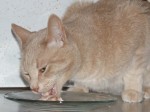A Raw Feeding Terminology Discussion
 Like most fields, the raw feeding world has its own terminology. If you’re new to the practice, you’re likely to run into unfamiliar terms, or words that don’t mean quite what you think they do. Here’s a quick rundown of the most commonly used words and phrases that inform raw feeding discussions.
Like most fields, the raw feeding world has its own terminology. If you’re new to the practice, you’re likely to run into unfamiliar terms, or words that don’t mean quite what you think they do. Here’s a quick rundown of the most commonly used words and phrases that inform raw feeding discussions.
Species-appropriate – A diet, environment, play pattern, etc. that is based upon the species-specific biological, physiological, or behavioral needs of the companion animal.
Whole Prey – A diet of small animals such as mice, rats, Guinea pigs, chicks, etc. Considered by most to be the most natural and beneficial of the raw diet types.
Prey Model Raw (PMR) – A diet of chunked meat, bone-in meals, and half organ/half meat meals fed using the 80/10/5/5 Guideline ( a rough average of typical feline prey percentages). PMR is the most popular and least expensive raw feeding option. It offers the dental and psychological benefits of whole prey and lacks the messy, time-consuming preparation of ground.
Frankenprey – A slang term for the PMR diet. (Note: CatCentric initially used this term but has since moved to the more conventional PMR.)
The 80/10/5/5 Guideline – Meals consisting of large chunks of meat, half organ/half meat, and/or edible bones wrapped in meat fed on a schedule in such a manner – 80% meat, 10% bone, 5% liver and 5% other organ – that at the end of a set time period (can be a day or a month, is usually a week) the cat will consume the animal parts in approximately the same percentages they would have had the meals consisted of whole prey. This formula has been used successfully by raw feeders for decades.
Biologically Appropriate Raw Food (BARF) – Coined by Dr. Ian Billinghurst, who sells a canine commercial food by that name and has a patent on it, a BARF diet consists of 60-80% raw meaty bones (RMBs) and 20-40% fruits and vegetables, offal, meat, eggs, or dairy foods. The BARF ingredient mix is rooted in the belief that dogs are omnivores with a carnivorous background, and such a diet should never be fed to cats.
Species-Appropriate Raw Food (SARF) – Occasionally used as a replacement for BARF.
Ground Diets – A diet created using either a recipe or the PMR guideline in which all of the ingredients are thoroughly mixed and ground to a somewhat fine texture. This diet is popular as a transition tool, as it most closely resembles the canned foods with which cats are familiar and is more readily accepted by them. All commercial raw diets are, at this time, ground.
Meats – Skin, sinew, tendons, gizzards, and muscle meat. Heart and lungs, though considered organs in most other instances, are considered “meats” in feline raw diets.
Organs – Secreting organs such as liver, kidney, pancreas, spleen, brain, eyes, testes, etc. (does NOT refer to heart or lung).
Bone-in Meals – Meals consisting of edible bones with a fair amount of muscle meat, tendons and cartilage still attached.
Edible Bone – Bone small enough or light enough for cats to eat: chicken wings, chicken ribs, quail bones, rabbit ribs and other small rabbit bones are all edible bones. Weight-bearing chicken bones (such as drumsticks and thigh bones) and turkey, beef, and pork bones are generally too thick or too dense to be considered edible (and may cause tooth damage if fed).
Hunger Pukes – When a cat has gone too long without food and stomach bile and acid has reached vomit-inducing levels. The vomit is typically clear to yellow and foamy. Hunger pukes can be avoided by feeding at least three meals a day.
Green Tripe – Not considered a meat or an organ, this is the fresh, unwashed and unbleached stomach of ruminating animals. It is popular as a naturally calcium/phosphorus balanced and nutrition-packed food full of probiotics and digestive enzymes.
Have you heard these terms before, or did one or two surprise you? Have you come across something I didn’t reference? If so, drop me a comment and I’ll add it to the list!
If you enjoyed this post or found it informative, please “Like” it, “Tweet” it, or share it using any of the buttons below. And don’t forget to check out our FB page, join the discussions in our awesome FB group and follow us on Twitter!


Comments
A Raw Feeding Terminology Discussion — No Comments